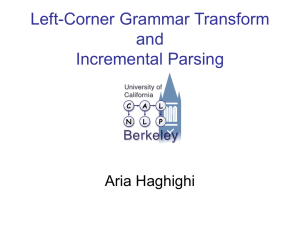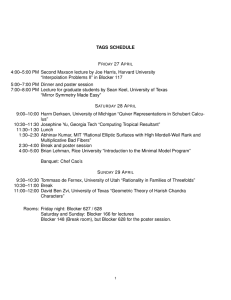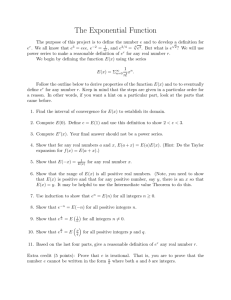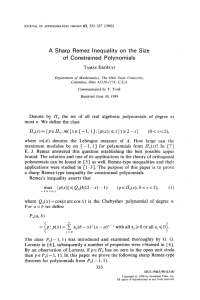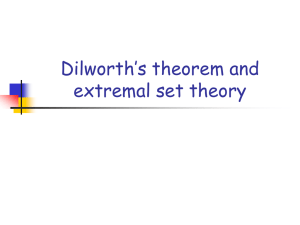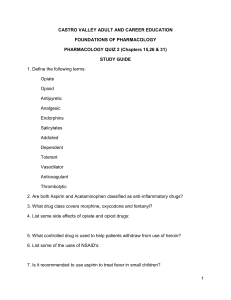EXTENDED BLOCKER, DELETION, AND CONTRACTION MAPS ON ANTICHAINS ANDREY O. MATVEEV
advertisement
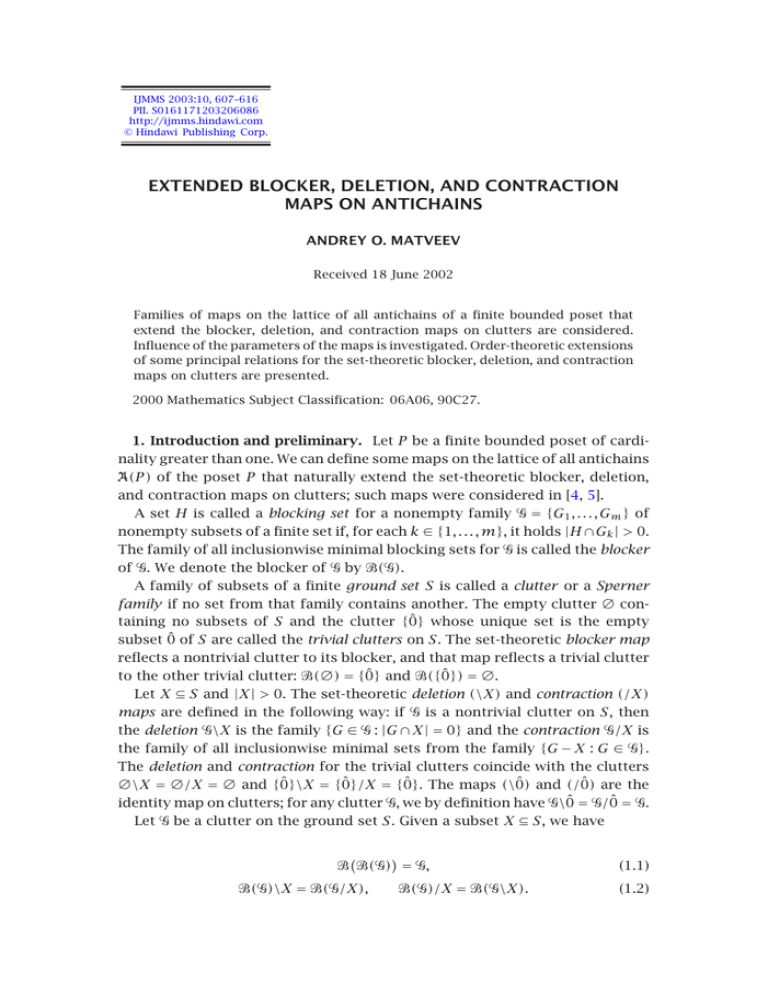
IJMMS 2003:10, 607–616
PII. S0161171203206086
http://ijmms.hindawi.com
© Hindawi Publishing Corp.
EXTENDED BLOCKER, DELETION, AND CONTRACTION
MAPS ON ANTICHAINS
ANDREY O. MATVEEV
Received 18 June 2002
Families of maps on the lattice of all antichains of a finite bounded poset that
extend the blocker, deletion, and contraction maps on clutters are considered.
Influence of the parameters of the maps is investigated. Order-theoretic extensions
of some principal relations for the set-theoretic blocker, deletion, and contraction
maps on clutters are presented.
2000 Mathematics Subject Classification: 06A06, 90C27.
1. Introduction and preliminary. Let P be a finite bounded poset of cardinality greater than one. We can define some maps on the lattice of all antichains
A(P ) of the poset P that naturally extend the set-theoretic blocker, deletion,
and contraction maps on clutters; such maps were considered in [4, 5].
A set H is called a blocking set for a nonempty family Ᏻ = {G1 , . . . , Gm } of
nonempty subsets of a finite set if, for each k ∈ {1, . . . , m}, it holds |H ∩Gk | > 0.
The family of all inclusionwise minimal blocking sets for Ᏻ is called the blocker
of Ᏻ. We denote the blocker of Ᏻ by Ꮾ(Ᏻ).
A family of subsets of a finite ground set S is called a clutter or a Sperner
family if no set from that family contains another. The empty clutter ∅ containing no subsets of S and the clutter {0̂} whose unique set is the empty
subset 0̂ of S are called the trivial clutters on S. The set-theoretic blocker map
reflects a nontrivial clutter to its blocker, and that map reflects a trivial clutter
to the other trivial clutter: Ꮾ(∅) = {0̂} and Ꮾ({0̂}) = ∅.
Let X ⊆ S and |X| > 0. The set-theoretic deletion (\X) and contraction (/X)
maps are defined in the following way: if Ᏻ is a nontrivial clutter on S, then
the deletion Ᏻ\X is the family {G ∈ Ᏻ : |G ∩ X| = 0} and the contraction Ᏻ/X is
the family of all inclusionwise minimal sets from the family {G − X : G ∈ Ᏻ}.
The deletion and contraction for the trivial clutters coincide with the clutters
∅\X = ∅/X = ∅ and {0̂}\X = {0̂}/X = {0̂}. The maps (\0̂) and (/0̂) are the
identity map on clutters; for any clutter Ᏻ, we by definition have Ᏻ\0̂ = Ᏻ/0̂ = Ᏻ.
Let Ᏻ be a clutter on the ground set S. Given a subset X ⊆ S, we have
Ꮾ Ꮾ(Ᏻ) = Ᏻ,
Ꮾ(Ᏻ)\X = Ꮾ(Ᏻ/X),
Ꮾ(Ᏻ)/X = Ꮾ(Ᏻ\X).
(1.1)
(1.2)
608
ANDREY O. MATVEEV
Recall that the atoms of the poset P are the elements covering its least element. Let X be a subset of the atom set P a of P . (We denote the empty subset
of P a by ∅a .) We use the denotation b : A(P ) → A(P ) for the order-theoretic
blocker map from [4], and we use the denotations (\X), (/X) : A(P ) → A(P ) for
the order-theoretic operators of deletion and contraction from [5], respectively.
We do not recall those concepts here because the map b is the (∅a , 0)-blocker
map from Definition 2.1 of the present paper and the maps (\X) and (/X)
are the (X, 0)-deletion and (X, 0)-contraction maps from Definition 3.1 of the
present paper, respectively.
For any antichain A of P , the following relations hold in A(P ):
b b b(A) = b(A),
(1.3)
b(A)\X ≤ b(A/X) ≤ b(A) ≤ b(A)/X ≤ b(A\X).
(1.4)
Equality (1.3) from [4] goes back to (1.1) from [2, 3]. Comparison (1.4) from [5]
goes back to (1.2) from [6].
In the present paper, we consider families of the so-called (X, k)-blocker,
(X, k)-deletion, and (X, k)-contraction maps on A(P ) parametrized by subsets
X ⊆ P a and numbers k ∈ N, k < |P a |. We show that for all pairs of the abovementioned parameters X and k, the essential properties of the maps remain
similar to those of the (∅a , 0)-blocker, (X, 0)-deletion, and (X, 0)-contraction
maps on A(P ) that were investigated in [4, 5]. In particular, we present analogues of relations (1.3) and (1.4) in Proposition 2.6(ii) and Theorem 3.7.
We refer the reader to [7, Chapter 3] for basic information and terminology
in the theory of posets.
We use min Q to denote the set of all minimal elements of a poset Q. If Q
has a least element, then it is denoted 0̂Q ; if Q has a greatest element, then it
is denoted 1̂Q .
Throughout the paper, P stands for a finite bounded poset of cardinality
greater than one, that is, P by definition has the least and greatest elements
that are distinct. We denote by I(A) and F(A) the order ideal and filter of P
generated by an antichain A, respectively.
All antichains of P compose a distributive lattice denoted A(P ); in the present paper, antichains are by definition partially ordered in the following way;
if A , A ∈ A(P ), then we set
A ≤ A
iff F A ⊆ F A .
(1.5)
We call the least and greatest elements 0̂A(P ) and 1̂A(P ) of A(P ) the trivial antichains of P because, in the context of the present paper, they are counterparts
of the trivial clutters. Here, 0̂A(P ) is the empty antichain of P and 1̂A(P ) the oneelement antichain {0̂P }. We denote by ∨ and ∧ the operations of join and meet
EXTENDED BLOCKER, DELETION, AND CONTRACTION MAPS . . .
609
in the lattice A(P ); if A , A ∈ A(P ), then
A ∨ A = min A ∪ A ,
A ∧ A = min F A ∩ F A .
(1.6)
2. (X, k)-blocker map. In this section, we consider a family of maps on antichains of a finite bounded poset that extend the set-theoretic blocker map
on clutters. From now on, X is always a subset of P a and k is a nonnegative
integer less than |P a |.
Definition 2.1. The (X, k)-blocker map on A(P ) is the map bkX : A(P ) →
A(P ),
A → min b ∈ P : I(b) ∩ I(a) ∩ P a − X > k ∀a ∈ A
(2.1)
if A is nontrivial, and
0̂A(P ) → 1̂A(P ) ,
1̂A(P ) → 0̂A(P ) .
(2.2)
Given an antichain A ∈ A(P ), the antichain bkX (A) is the (X, k)-blocker of A
in P .
a
We use the denotations bk and bX instead of the denotations bk∅ and b0X ,
respectively. The (∅a , 0)-blocker map is the blocker map b on A(P ) considered
in [4]. Given A ∈ A(P ), the antichain b(A) is called the blocker of A in P .
If {a} is a one-element antichain of P , then we write bkX (a) instead of bkX ({a}).
Let a ≠ 0̂P . Since the blocker map on A(P ) is antitone, for every E ⊆ b(a) − X,
we have {a} ≤ b(b(a)) ≤ b(b(a) − X) ≤ b(E) ≤ b(a).
The following statement immediately follows from Definition 2.1.
Lemma 2.2. Let A be a nontrivial antichain of P . If bkX (A) ≠ 0̂A(P ) , then, for
each a ∈ A and for all b ∈ bkX (A), it holds that
I(a) ∩ I(b) ∩ P a − X > k.
(2.3)
Let a ∈ P , a ≠ 0̂P . From now on, ᐀a denotes the family of subsets of the
atom set P a defined as follows:
᐀a = E ⊆ b(a) − X : |E| = k + 1 .
(2.4)
Let L(P a ) denote the Boolean lattice of all subsets of the atom set P a , and let
L(P a )(k+1) denote the subset of all elements of rank k + 1 of L(P a ). Given a
(k + 1)-subset E ⊆ P a , we denote by ε(E) the least upper bound for E in L(P a );
conversely, given an element e ∈ L(P a )(k+1) , we denote by ε−1 (e) the (k + 1)subset of all atoms of L(P a ) that are comparable with e.
610
ANDREY O. MATVEEV
Let A be a nontrivial antichain of P . If |b(a) − X| ≤ k for some a ∈ A,
then Definition 2.1 implies bkX (A) = 0̂A(P ) . In the case |b(a) − X| > k for all
a ∈ A, Proposition 2.3 describes two alternative ways of elementwise finding
the (X, k)-blocker of A; it involves the set-theoretic blocker Ꮾ(·) of a set family.
Proposition 2.3. Let A be a nontrivial antichain of P . If |b(a)−X| > k, for
all a ∈ A, then
bkX (A) =
b(E) =
a∈A E∈᐀a
b ε−1 (e) .
(2.5)
E∈Ꮾ({{ε(E):E∈᐀a } : a∈A}) e∈E
Proof. We have
bkX (A) =
bkX (a),
(2.6)
a∈A
and an order-theoretic argument shows that, for every a ∈ A, it holds that
bkX (a) =
b(E),
(2.7)
E∈᐀a
where b(E) = e∈E {e}.
The inclusion bkX (A) ⊇ E∈Ꮾ({{ε(E):E∈᐀a }:a∈A}) e∈E b(ε−1 (e)) follows from
Definition 2.1. To prove the inclusion
bkX (A) ⊆
b ε−1 (e) ,
(2.8)
E∈Ꮾ({{ε(E):E∈᐀a }:a∈A}) e∈E
assume that it does not hold. Consider an element b ∈ bkX (A) such that it does
not belong to the right-hand side of (2.8). In this case, there is an element a ∈ A
such that |I(b) ∩ I(a) ∩ (P a − X)| ≤ k. It means that the left-hand side of (2.8)
is not an (X, k)-blocker of A, a contradiction.
The following lemma clarifies how the parameters of the (X, k)-blocker map
influence the image of A(P ); additionally, the lemma states that bkX is antitone.
Lemma 2.4. (i) Let Y ⊆ P a , Y ⊇ X, and let j be a nonnegative integer, j ≤ k.
If A ∈ A(P ), then
bjX (A) ≥ bkX (A) ≥ bkY (A).
(2.9)
(ii) For all A , A ∈ A(P ) such that A ≤ A , it holds that
bkX (A ) ≥ bkX (A ).
(2.10)
EXTENDED BLOCKER, DELETION, AND CONTRACTION MAPS . . .
611
Proof. (i) There is nothing to prove if A is trivial. Suppose that A is a
nontrivial antichain of P . For each element a ∈ A, we by (2.7) have
bkX (a) =
b(E) ≥
E∈᐀a
b(E) = bkY (a).
(2.11)
E⊆b(a)−Y :
|E|=k+1
With respect to (2.6), this yields
bkX (A) =
bkX (a) ≥
a∈A
bkY (a) = bkY (A).
(2.12)
a∈A
The relation bjX (A) ≥ bkX (A) is proved in a similar way.
(ii) If A is a trivial antichain, then the assertion immediately follows from
Definition 2.1. Suppose that A is nontrivial. For every a ∈ A , there is a ∈ A
such that {a } ≤ {a } and, as a consequence, it holds the inclusion b(a ) ⊇
b(a ), (2.7) implies bkX (a ) ≥ bkX (a ), and the proof is completed by applying
(2.6).
In addition to Lemma 2.4(ii), we need the following statement to describe
the structure of the image of A(P ) under the (X, k)-blocker map.
Lemma 2.5. For any A ∈ A(P ), it holds that
bkX bkX (A) ≥ A.
(2.13)
Proof. If A is a trivial antichain of P , then the lemma follows from
Definition 2.1 because, in this case, we have bkX (bkX (A)) = A. Suppose that A
is nontrivial. If bkX (A) = 0̂A(P ) , then we have bkX (bkX (A)) = 1̂A(P ) ≥ A and we are
done. Finally, suppose that bkX (A) is a nontrivial antichain. On the one hand,
according to Lemma 2.2, for each a ∈ A and for all b ∈ bkX (A), it holds that
I(a) ∩ I(b) ∩ P a − X > k.
(2.14)
On the other hand, we, by Definition 2.1, have
bkX bkX (A) = min g ∈ P : I(g) ∩ I(b) ∩ P a − X > k ∀b ∈ bkX (A) .
(2.15)
Hence, we have bkX (bkX (A)) ≥ A.
We complete this section by applying a standard technique of the theory of
posets to the lattice A(P ) and the (X, k)-blocker map on it. See, for instance,
[1, Chapter IV] on (co)closure operators.
612
ANDREY O. MATVEEV
Proposition 2.6. (i) The composite map bkX ◦ bkX is a closure operator on
A(P ).
X
(ii) The poset BX
k (P ) = {bk (A) : A ∈ A(P )} is a self-dual lattice; the restriction
X
X
map bk |BX (P ) is an anti-automorphism of BX
k (P ). The lattice Bk (P ) is a meetk
subsemilattice of the lattice A(P ).
X −1
(iii) For every B ∈ BX
k (P ), its preimage (bk ) (B) under the (X, k)-blocker
map is a convex join-subsemilattice of the lattice A(P ). The greatest element of
(bkX )−1 (B) is bkX (B).
Proof. In view of Lemmas 2.4(ii) and 2.5, assertions (i) and (ii) are a corollary of [1, Propositions 4.36 and 4.26]. To prove (iii), choose arbitrary elements A , A ∈ (bkX )−1 (B), where B = bkX (A) for some A ∈ A(P ), and note that
bkX (A ∨A ) = bkX (A )∧bkX (A ) = B. If B = 0̂A(P ) , then bkX (B) = 1̂A(P ) is the greatest element of (bkX )−1 (B). If B = 1̂A(P ) , then (bkX )−1 (B) is the one-element subposet {0̂A(P ) } of A(P ). Finally, if B is a nontrivial antichain of P , then the element bkX (B) = bkX (bkX (A)) is by (2.15) the greatest element of (bkX )−1 (B). Since
the (X, k)-blocker map is antitone, we can see that the subposet (bkX )−1 (B) of
A(P ) is convex.
We call the poset BX
k (P ) from Proposition 2.6(ii) the lattice of (X, k)-blockers
a
in P . The poset B(P ) = B∅
0 (P ) is called in [4] the lattice of blockers in P .
3. (X, k)-deletion and (X, k)-contraction maps. In this section, we consider
order-theoretic extensions of the set-theoretic deletion and contraction maps
on clutters.
Definition 3.1. (i) If {a} is a nontrivial one-element antichain of P , then
the (X, k)-deletion {a}\k X and (X, k)-contraction {a}/k X of {a} in P are the
antichains
{a}\k X =
{a},
0̂A(P ) ,
if b(a) ∩ X ≤ k,
if b(a) ∩ X > k,
{a},
{a}/k X = bkX bkX (a) ,
1̂
,
A(P )
(3.1)
if b(a) ∩ X ≤ k,
if b(a) ∩ X > k, b(a) ⊆ X,
if b(a) ∩ X > k, b(a) ⊆ X.
(3.2)
(ii) If A is a nontrivial antichain of P , then the (X, k)-deletion A\k X and
(X, k)-contraction A/k X of A in P are the antichains
A\k X =
{a}\k X ,
a∈A
A/k X =
{a}/k X .
a∈A
(3.3)
EXTENDED BLOCKER, DELETION, AND CONTRACTION MAPS . . .
613
(iii) The (X, k)-deletion and (X, k)-contraction of the trivial antichains of P
are
0̂A(P ) \k X = 0̂A(P ) /k X = 0̂A(P ) ,
1̂A(P ) \k X = 1̂A(P ) /k X = 1̂A(P ) .
(3.4)
(iv) The map
\k X : A(P ) → A(P ),
A → A\k X,
(3.5)
A → A/k X,
(3.6)
is the operator of (X, k)-deletion on A(P ).
The map
/k X : A(P ) → A(P ),
is the operator of (X, k)-contraction on A(P ).
Given an antichain A ∈ A(P ), we use the denotations A\X and A/X instead of the denotations A\0 X and A/0 X, respectively. The (X, 0)-deletion map
(\X) : A(P ) → A(P ) and the (X, 0)-contraction map (/X) : A(P ) → A(P ) are the
operators of deletion and contraction on A(P ), respectively, considered in [5].
The following observation is an immediate consequence of Definition 3.1. If
a , a ∈ P and {a } ≤ {a } in A(P ), then
{a }\k X ≤ {a }\k X,
{a }/k X ≤ {a }/k X;
(3.7)
hence, in view of (3.3) and (3.4), we can formulate the following lemma.
Lemma 3.2. If A , A ∈ A(P ) and A ≤ A , then
A \k X ≤ A \k X,
A /k X ≤ A /k X.
(3.8)
Moreover, if {a} is a one-element antichain of P , then we have
{a}\k X ≤ {a} ≤ {a}/k X,
(3.9)
and a more general statement is true.
Lemma 3.3. If A ∈ A(P ), then
A\k X ≤ A ≤ A/k X.
(3.10)
Another consequence of Definition 3.1 is that, for a one-element antichain
{a} of P , it holds that
bkX (a)\k X ≤ bkX {a}/k X ≤ bkX (a) ≤ bkX (a)/k X ≤ bkX {a}\k X .
(3.11)
614
ANDREY O. MATVEEV
Let {a} be a nontrivial one-element antichain of P . We obviously have
({a}\k X)\k X = {a}\k X. We show that ({a}/k X)/k X = {a}/k X. If |b(a) ∩ X| ≤ k,
then Definition 3.1 implies ({a}/k X)/k X = {a}/k X = {a}; further, if |b(a)∩X| >
k and b(a) ⊆ X, then Definition 3.1 implies ({a}/k X)/k X = {a}/k X = 1̂A(P ) . Suppose that |b(a) ∩ X| > k and b(a) ⊆ X. In this case, on the one hand, we have
({a}/k X)/k X ≥ {a}/k X by Lemma 3.3, on the other hand, for every element
b ∈ {a}/k X = bkX (bkX (a)), we have bkX (b) ≥ bkX (a), and, as a consequence, we
have ({a}/k X)/k X = b∈{a}/k X ({b}/k X) ≤ bkX (bkX (a)) = {a}/k X. We arrive at the
conclusion that ({a}/k X)/k X = {a}/k X. With respect to (3.3), we can formulate
the following lemma.
Lemma 3.4. If A ∈ A(P ), then
A\k X \k X = A\k X,
A/k X /k X = A/k X.
(3.12)
Lemmas 3.2, 3.3, and 3.4 lead to a characterization of the (X, k)-deletion and
(X, k)-contraction maps in terms of (co)closure operators.
Proposition 3.5. The map (\k X) is a coclosure operator on A(P ). The map
(/k X) is a closure operator on A(P ).
The following proposition is a counterpart of Lemma 2.4(i).
Proposition 3.6. Let Y ⊆ P a , Y ⊇ X, and let m be an integer, k ≤ m < |P a |.
If A ∈ A(P ), then
A\m X ≥ A\k X ≥ A\k Y ,
A/k X ≤ A/k Y ≤ A/m Y .
(3.13)
Proof. If A is a trivial antichain, then the proposition follows from (3.4).
Suppose that A is nontrivial. For each a ∈ A, (3.1) implies {a}\k X ≥ {a}\k Y ,
(3.2) implies {a}/k X ≤ {a}/k Y , and (3.3) yields
A\k X =
{a}\k X ≥
{a}\k Y = A\k Y ,
a∈A
a∈A
A/k X =
{a}/k X ≤
{a}/k Y = A/k Y .
a∈A
(3.14)
a∈A
Other relations are proved in a similar way.
We denote the images (\k X)(A(P )) = {A\k X : A ∈ A(P )} and (/k X)(A(P )) =
{A/k X : A ∈ A(P )} by A(P )\k X and A(P )/k X, respectively. We can interpret
well-known properties of (semi)lattice maps and (co)closure operators on lattices in the case of the (X, k)-deletion and (X, k)-contraction maps.
EXTENDED BLOCKER, DELETION, AND CONTRACTION MAPS . . .
615
Definition 3.1 implies that the maps (\k X), (/k X) : A(P ) → A(P ) are upper
{0̂A(P ) , 1̂A(P ) }-homomorphisms, that is, for all A , A ∈ A(P ), we have (A ∨
A )\k X = (A \k X)∨(A \k X) and (A ∨A )/k X = (A /k X)∨(A /k X), and, moreover, we have 0̂A(P ) \k X = 0̂A(P ) /k X = 0̂A(P ) and 1̂A(P ) \k X = 1̂A(P ) /k X = 1̂A(P ) .
The posets A(P )\k X and A(P )/k X, with the partial orders induced by the
partial order on A(P ), are lattices.
We call the poset A(P )\k X the lattice of (X, k)-deletions in P , and we call the
poset A(P )/k X the lattice of (X, k)-contractions in P .
The lattice A(P )\k X is a join-subsemilattice of A(P ). Denote by ∧A(P )\k X the
operation of meet in A(P )\k X. If D , D ∈ A(P )\k X, then we have D ∧A(P )\k X
D = (D ∧ D )\k X.
The lattice A(P )/k X is a sublattice of A(P ).
If D ∈ A(P )\k X, then the preimage (\k X)−1 (D) of D under the (X, k)-deletion
map is the closed interval [D, D ∨ E⊆X:|E|=k+1 b(E)] of A(P ).
If D ∈ A(P )/k X, then the preimage (/k X)−1 (D) of D under the (X, k)contraction map is a convex join-subsemilattice of the lattice A(P ), with the
greatest element D.
Relations (1.2) and (1.4) have the following analogue.
Theorem 3.7. If A ∈ A(P ), then
bkX (A)\k X ≤ bkX A/k X ≤ bkX (A) ≤ bkX (A)/k X ≤ bkX A\k X .
(3.15)
Proof. There is nothing to prove if A is a trivial antichain. Suppose that A
is nontrivial. The relations
bkX (A)\k X ≤ bkX (A) ≤ bkX (A)/k X,
bkX A/k X ≤ bkX (A) ≤ bkX A\k X
(3.16)
follow from Lemmas 3.3 and 2.4(ii).
We need the following auxiliary relations. If A and A are arbitrary antichains of P , then
(A ∧ A )\k X ≤ A \k X ∧ A \k X ,
(A ∧ A )/k X ≤ A /k X ∧ A /k X .
(3.17)
(3.18)
To prove bkX (A)\k X ≤ bkX (A/k X), we use (3.17) and (3.11), and we see that
bkX (A)\k X
=
bkX (a)
a∈A
= bkX
\k X ≤
bkX (a)\k X ≤
bkX {a}/k X
a∈A
{a}/k X = bkX A/k X .
a∈A
a∈A
(3.19)
616
ANDREY O. MATVEEV
To prove bkX (A)/k X ≤ bkX (A\k X), we use (3.18) and (3.11), and we see that
bkX (A)/k X
=
bkX (a)
a∈A
= bkX
/k X ≤
bkX (a)/k X ≤
bkX {a}\k X
a∈A
{a}\k X = bkX A\k X .
a∈A
(3.20)
a∈A
References
[1]
[2]
[3]
[4]
[5]
[6]
[7]
M. Aigner, Combinatorial Theory, Grundlehren der Mathematischen Wissenschaften, vol. 234, Springer-Verlag, Berlin, 1979.
J. Edmonds and D. R. Fulkerson, Bottleneck extrema, J. Combinatorial Theory 8
(1970), 299–306.
A. Lehman, A solution of the Shannon switching game, J. Soc. Indust. Appl. Math.
12 (1964), 687–725.
A. O. Matveev, On blockers in bounded posets, Int. J. Math. Math. Sci. 26 (2001),
no. 10, 581–588.
, A note on operators of deletion and contraction for antichains, Int. J. Math.
Math. Sci. 31 (2002), no. 12, 725–729.
P. D. Seymour, The forbidden minors of binary clutters, J. London Math. Soc. (2) 12
(1975/1976), no. 3, 356–360.
R. P. Stanley, Enumerative Combinatorics. Vol. 1, Cambridge Studies in Advanced
Mathematics, vol. 49, Cambridge University Press, Cambridge, 1997.
Andrey O. Matveev: Data-Center Company, RU-620034, P.O. Box 5, Ekaterinburg,
Russia
E-mail address: aomatveev@dc.ru

